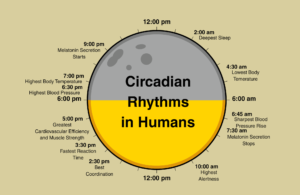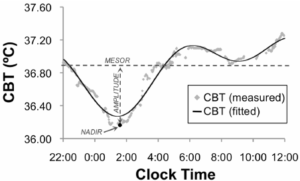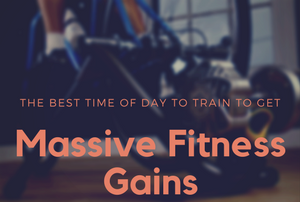Most people don't think about what time of day they train and how that can affect their fitness gains. In fact, a lot of people simply look at their training plan, jump on their bike and go when they have some free time. And that's fine if you're looking to make some improvements from baseline. But what if you're looking for that extra few percentage points to help get you onto the podium? What if you're pushing for that big century goal and you need to shave off a few more minutes?
If you're a pro, you plan life around training, but if you're a Joe, you plan training around life. When you have to plan training around life, time of day can make a big difference in the fitness gains you see.
On this episode of the Tailwind Coaching Podcast, I'll explain to you how the time of day can affect your training. We'll go over how to determine the best time of day for your body to train and what you gain by figuring that out. You'll also get a few tips and tricks to help you minimize the impact of training off your “peak” time of day.
So if you're ready to biohack your training time and get bigger fitness gains out of the hours you spend on the bike, click through the jump and listen to this episode of the Tailwind Coaching Podcast. Don't forget to share with your friends and rate the podcast on iTunes!
Podcast: Play in new window | Download (Duration: 40:14 — 30.8MB)
Subscribe: RSS
What is biorhythm?
Most people don't think about what time of day they should train. Most people simply think “I've got a workout to do today, I'll get it done.” No consideration is given to what time of day yields the best results. This is the difference between professionals and amateurs: professionals plan their life around training, amateurs plan training around their life.
There is definitely a lot of science behind determining optimal training time. Circadian rhythm, hormonal rhythm, and gene expression cycles can all create peak and off-peak training times. Training during peak times will allow you to recover faster and ultimately be faster, stronger and more injury resistant.
 Circadian rhythm and physiology
Circadian rhythm and physiology
Circadian rhythm is simply a daily cycle of physiological activity within your body. The most obvious example of this rhythm is your sleep/wake cycle. Essentially, your brain controls your “internal clock” through a small region called the Suprachiasmatic Nucleus (SCN). It functions a bit like a pacemaker, acting as an internal clock to manage your body systems.
The SCN controls all of your body's timing, which includes hormonal balance and core body temperature. Here's a quick rundown of some of the important times in a 24-hour cycle that may apply to your training plans:
- Maximal cortisol production – 8 AM
- Highest alertness – 10 AM
- Best coordination – 2:30 PM
- Fastest reaction times – 3:30 PM
- Greatest cardiovascular efficiency – 5 PM
- Highest core body temperature – 7 PM
As you can see, there's not a lot going on in the morning. Keep in mind that these clock times are based on a typical 9 to 5 worker who sleeps from 12 to 8.
What does hormonal rhythm have to do with fitness gains?
Hormonal rhythm is key to building big fitness gains. If you're training at the right time of day, you're training with your body, not against it.
The big player here is testosterone to cortisol ratio. T/C ratio is a measure of training status and a big indicator of overtraining. Cortisol is a catabolic hormone that breaks down tissues and prepares our body to run from danger. Or, in the case of training, it liberates energy substrates for use in exercise. Testosterone is an anabolic hormone that helps build muscle and repair the damage done by training stresses. Testosterone production is low during the day and higher at night. Cortisol peaks in the morning and dips as the day goes on.
Because of this timing, the T/C ratio is highest in the afternoon/evening. Training during this time leads to the smallest increase in cortisol and the largest increase in testosterone. Elevation of cortisol is also mitigated quickly during the evening hours. That points to the evening as a prime time to train and excel.
 How core body temp dictates fitness gains
How core body temp dictates fitness gains
Core body temperature is the temperature at which your physiological processes occur. Your body temperature range is regulated by an extremely tight range because enzymatic reactions are sensitive to minor changes in temperature. These enzymatic reactions are the ones involved in the citric acid cycle and electron transport change, among others.
Slight elevations in core body temperature can stimulate increased enzymatic activity. That increase in core temperature typically happens in the evening. It's no secret that most sports records are broken in the early evening for this reason.
In addition to increased enzymatic activity, nerve conduction velocity, blood flow, and mobility are optimized during the evening. That means the body is perfectly primed for optimal performance and increased fitness gains in the evening.
The best time of day to train for big fitness gains
Based on all the factors affecting body temperature, hormonal rhythm and circadian rhythm, the best time of day to train is in the late afternoon to early evening. Planning your workouts between 2:30 PM and 8:30 PM will lead to optimal fitness gains. If your workouts are longer than an hour, consider training earlier during that window. Of course, that time frame assumes you're a typical 9 to 5 worker. If you're a shift worker or keep odd sleeping hours, make sure you have around 6 hours between waking up and training.
Finding your personal optimal training time
Not everyone has the same timing of their circadian rhythm. Some people perform better in the mornings compared to the biological peak in the evening. This often comes down to alertness or mental motivation. However well you perform in the mornings, you will still see greater physiological gains by training in the afternoon. But those gains are nothing if you can't motivate yourself to train in the evenings.
Since peak performance and exercise adaptations are strongly correlated, I'd suggest training when you perform at your best. For racers, you'll know when you race the best and get the best results. If you don't know what your peak performance time may be, you can use resting heart rate to figure it out.
Because resting heart rate is strongly correlated with core body temperature, measuring heart rate over the course of a week can give you an idea of what your peak training time is. Since you (probably) have a heart rate monitor already, resting heart rate is a perfect way to determine your peak performance time.
 Kickstart morning training sessions
Kickstart morning training sessions
If you absolutely must train in the mornings, one option to help optimize your performance is a caffeine-containing pre-workout supplement. This can be a bit of coffee or a dedicated pre-workout supplement. Aim for around 250mg (3 mg/kg of body weight) for the average 80 kg cyclist. Adjust it as necessary if you're larger or smaller than that.
Caffeine isn't the cure-all to morning training though. Caffeine actually decreases the testosterone to cortisol ratio and it doesn't boost growth hormone levels to afternoon concentrations. It's also really easy to develop a tolerance to caffeine with just 50 to 100 mg per day.
Note that you can still drink something that contains caffeine in the evening to get a further performance boost. However, keep in mind that caffeine can interfere with your sleep, so the benefits may not outweigh the risks.
Another option to consider is taking a nice, long, hot shower in the morning. Since performance can be tied to core body temperature, raising that core body temp in the morning has added benefits in mitigating the early morning training deficit. If you have access to a sauna, that's probably better still.
If you're going to do it “wrong”, always do it “wrong”
Should you be forced to train at a suboptimal time, do it at the same time every day. The more frequently you stick to a morning routine, the more your body will adapt its circadian rhythm to that routine. Make sure that you separate your training from “optimal” training time by several hours. The bigger the difference between your optimal training time and the time you actually train, the more pronounced the adaptation.
You'll never get a complete adaptation, though. The nervous system is very pliable and able to adapt well to changes in circadian rhythm. Hormone cycles and gene expression are not as adaptable, so you'll lose out on something. Still, if you have to do it “wrong” it's best to minimize the damage as much as possible.
The biggest exception to this rule:
For those of you who have mentally stressful or physically taxing jobs, you may want to switch training to the mornings or during lunch. The fatigue from a long day of work can easily override the benefits of training later in the day. So if you're a manual laborer or deal with mentally taxing work all day, consider moving your training to lunchtime or earlier. Keep your workouts on the shorter side too, since your body is going to be beaten up from a day at the office (or salt mines, whichever.)
The take-home message
Not many people actually take time of day into account when planning their training programs. By ignoring that simple fact, you could be leaving massive fitness gains on the table. Those fitness gains could even be the difference between winning and slipping off the podium.
So to double down on things, remember that you're (probably) not a pro. Pros plan their life around training. Joes plan their training around life. If you want to maximize the training time you have, plan the right time to train based on your circadian rhythm which manages your biological processes.
Remember that your hormonal patterns, core body temperature, and gene expression are all tied to your circadian rhythm. The best time to take advantage of your peak performance time is between 2:30 and 8:30 if you sleep during the night and work during the day. If you're not sure what your optimal training time is, grab your HRM and start charting resting heart rate, which is correlated with core body temperature. Finally, if you can't train when you're on “peak” supplement your body with some caffeine or raise your core body temperature to help offset the poor timing.
Now that you've got the tools to perfect your training timing, take a look at when you're riding and how you can squeeze more out of it.
If you like what you heard, don't forget to rate the podcast on iTunes
